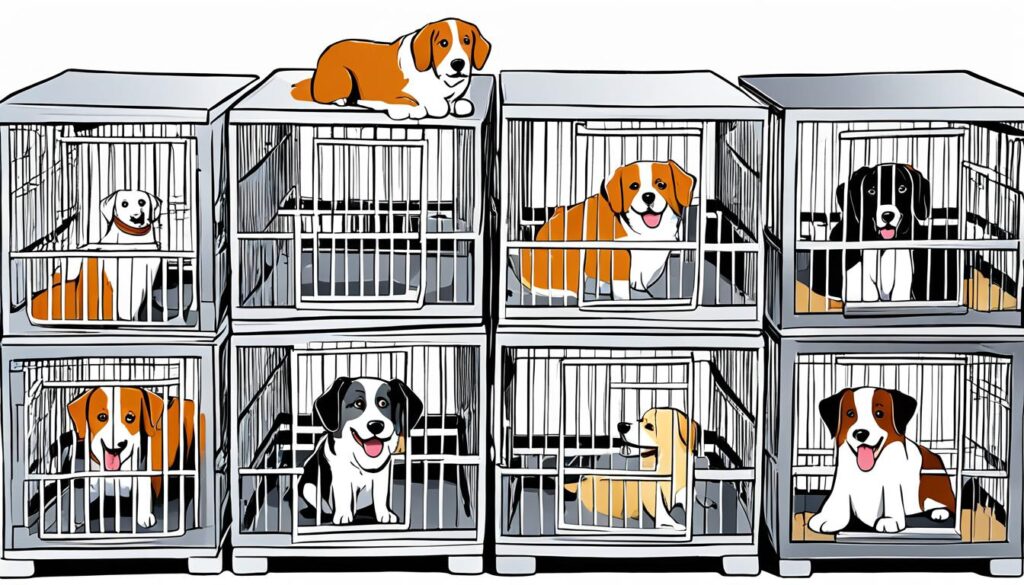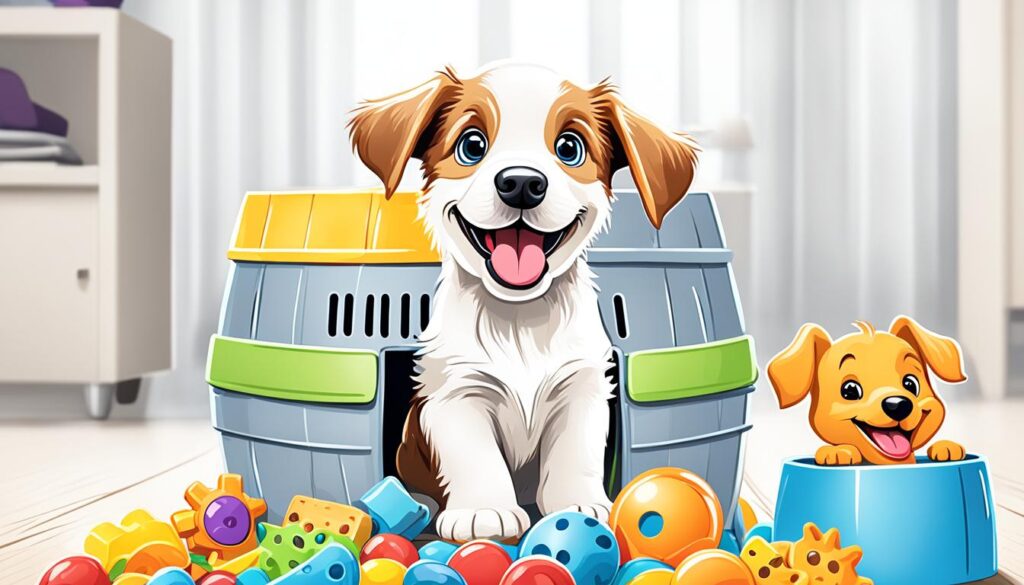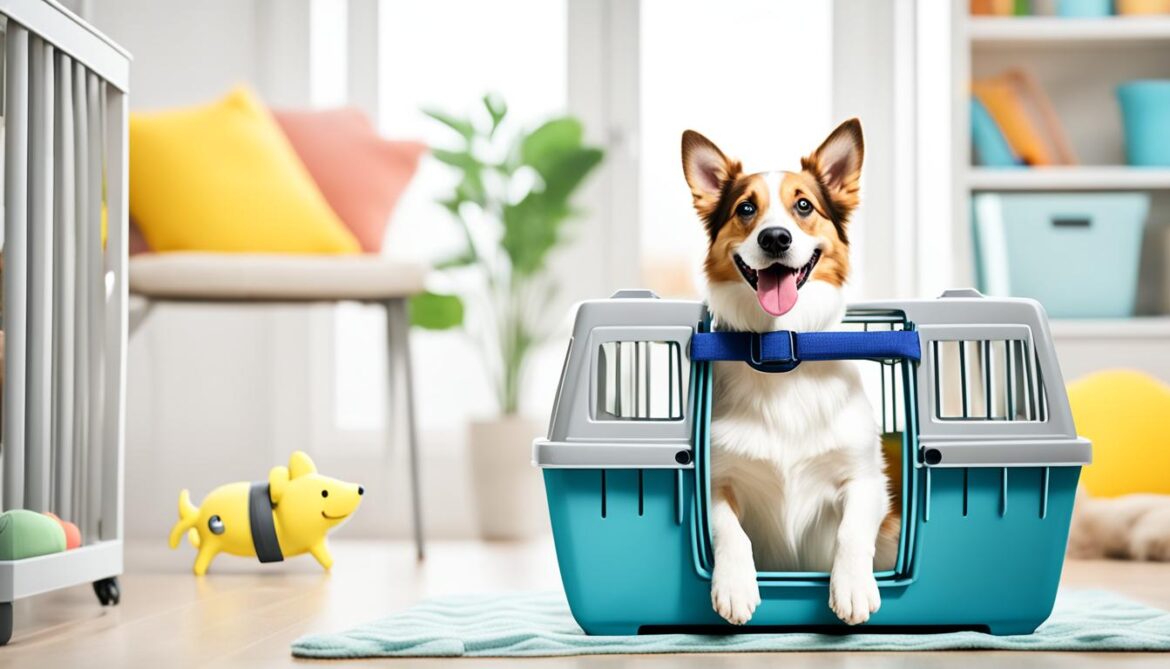Imagine coming home to a well-behaved, happy dog who greets you with a wagging tail and a smile on their face. Picture a life where your furry friend understands the rules of the house, relieves themselves outside, and enjoys their own cozy space. This can be your reality with effective dog crate training.
Whether you have a new puppy or an older dog, crate training for dogs can be a game-changer. It’s not about confining your pup; it’s about providing them with a secure den-like environment where they feel safe and comfortable. Crate training can be the key to unlocking a peaceful home and a well-adjusted furry companion.
In this article, we will guide you through quick tips for successful puppy crate training. Get ready to embark on a journey that will strengthen the bond between you and your four-legged friend, while creating a harmonious living environment for everyone involved.
Key Takeaways:
- Effective dog crate training can lead to a well-behaved and happy pup.
- Crate training provides a safe and secure space for your dog.
- By following these quick tips, you can create a peaceful home environment.
- Consistency and patience are key to successful crate training.
- Investing time in crate training can result in a lifetime of happiness for your dog.
Understanding the Importance of Crate Training
Crate training offers numerous benefits for both you and your dog. It is an effective method for teaching and shaping desired behaviors, as well as providing a safe and comfortable space for your furry friend. Let’s explore the significant benefits of crate training in detail.
Housetraining Made Easier
Crate training can greatly speed up the housetraining process. Dogs have a natural instinct to keep their sleeping area clean, so when properly introduced to a crate, they are less likely to eliminate inside it. By using a crate during housetraining, you create a consistent routine that reinforces your dog’s natural desire for cleanliness.
Preventing Destructive Behavior
Whether you have a curious puppy or an adult dog with separation anxiety, crate training can help prevent destructive behaviors. When left alone, dogs may chew on furniture, shoes, or other household items. By providing a safe and secure crate, you limit their access to potential hazards and promote appropriate chewing on designated toys and treats.
A Safe Haven for Your Dog
“The crate serves as a den-like space where your dog can retreat to feel secure and relaxed.”
Just like humans, dogs need a place to call their own. The crate serves as a den-like space where your dog can retreat to feel secure and relaxed. It becomes their personal sanctuary, providing comfort during times of stress, loud noises, or when they simply need a break from the chaos of everyday life.
Facilitating Travel and Vet Visits
Crate training not only benefits your dog at home but also when traveling or visiting the veterinarian. Dogs who are crate trained can easily adapt to new environments and situations, making travel less stressful and veterinary visits more manageable. Crates provide a familiar and comforting space for your dog, wherever they may go.
Peace of Mind for You
By crate training your dog, you gain peace of mind knowing they are safe and secure when you can’t supervise them. Whether you’re running errands, at work, or asleep at night, you can rest assured knowing that your dog is comfortable in their crate, minimizing the risk of accidents or getting into mischief.
| Benefits of Crate Training for Dogs |
|---|
| Housetraining made easier |
| Prevents destructive behavior |
| Creates a safe haven |
| Facilitates travel and vet visits |
| Provides peace of mind for dog owners |
As you can see, crate training offers a wide range of benefits for both you and your beloved canine companion. From facilitating housetraining and preventing destructive behavior to creating a safe haven and providing peace of mind, the advantages are clear. Embrace crate training as an essential aspect of dog ownership and unlock the tremendous benefits it brings to your dog’s behavior and well-being.
Choosing the Right Crate for Training
Not all dog crates are created equal. When it comes to crate training your furry friend, selecting the right crate size, material, and features can make all the difference in ensuring a positive training experience. Here, we’ll guide you through the process of choosing the best dog crates for training.
Crate Size: The size of the crate is an important consideration to ensure your dog feels safe and comfortable. A crate that is too small can make your dog feel cramped, while a crate that is too large may encourage accidents or your dog using one end for sleeping and the other for eliminating waste. As a general rule, choose a crate size that allows your dog to stand, turn around, and lie down comfortably.
Material: Dog crates come in various materials such as wire, plastic, and fabric. Wire crates are sturdy, breathable, and provide good visibility, while plastic crates are durable, easy to clean, and offer more privacy. Fabric crates are lightweight and portable but may not be suitable for dogs that are prone to chewing or scratching. Consider your dog’s needs and your specific training goals when selecting the right material for their crate.
Features: Pay attention to the features that can enhance your dog’s experience in the crate. Some crates have double doors for convenient access and positioning, while others have divider panels that allow you to adjust the crate’s size as your dog grows. Additionally, crates with removable trays or easy-to-clean bottoms can simplify the cleaning process.
By carefully considering the crate size, material, and features, you can ensure that your dog’s crate training is a positive experience that sets them up for success. Remember to gradually introduce your dog to the crate and make it a comfortable and inviting space for them. From cozy bedding to their favorite toys, make the crate an appealing and secure environment that your dog will love.

Now that you know how to choose the perfect crate for your dog, let’s move on to the next section where we’ll discuss establishing a crate training schedule. A consistent schedule will help your dog adapt to their crate and make the training process even more effective.
Establishing a Crate Training Schedule
Consistency is key when crate training a dog. A well-structured crate training schedule will help your pup adapt to their crate more easily and promote successful training. By establishing a routine for crate usage, meal times, potty breaks, and alone time, you can create a sense of security and predictability for your furry friend.
Meal Times
Set specific meal times for your dog and incorporate the crate into their feeding routine. This not only helps establish a schedule but also encourages your pup to associate the crate with positive experiences. Place their food bowl inside the crate, allowing them to enjoy their meal in a safe and comfortable environment. Remember to remove the food bowl once they finish eating to avoid any potential accidents.
Potty Breaks
Regular bathroom breaks are crucial during crate training. Take your dog outside for potty breaks at consistent intervals throughout the day. Pay attention to their behavior and signs that they need to relieve themselves, such as sniffing and circling. When they do their business outside, reward them with praise and treats to reinforce good behavior. Remember, puppies have smaller bladders and will need more frequent potty breaks compared to adult dogs.
Alone Time
Gradually increase the duration of crate time to help your dog become comfortable with being alone. Start with short periods and gradually extend the duration. Leaving your dog in their crate for longer intervals prepares them for times when you need to leave the house or when they have to spend time alone. Ensure that they have access to water and engaging toys to keep them occupied during these alone times.
Consistency, patience, and positive reinforcement are key to successful crate training. With a well-established crate training schedule, your dog will learn to view their crate as their safe haven.
Remember, crate training is a gradual process, and each dog will respond differently. Be patient and observe your dog’s behavior to make adjustments if necessary. With time and consistency, your furry friend will adapt to their crate and enjoy the benefits it brings to their overall well-being.
Effective Crate Training Methods
When it comes to crate training your dog, there are various methods you can choose from based on your furry friend’s personality and specific needs. By following step-by-step techniques and implementing these tips, you can ensure successful crate training for your canine companion.
A Positive Introduction
It’s important to create a positive association with the crate from the beginning. Start by introducing your dog to the crate gradually. Place their favorite toys or treats inside the crate to entice them to explore. Allow them to enter and exit the crate freely without closing the door initially. This will help your dog to view the crate as a safe and rewarding space.
“A positive introduction to the crate sets the foundation for successful crate training.” – Dog Trainer, Emily Williams
Crate Time for Meals and Rest
One effective method is to use the crate during meal times and resting periods. Place your dog’s meals or treats inside the crate, encouraging them to enter and enjoy their food. This creates a positive association with the crate and helps establish it as their den. Similarly, encourage your dog to relax or sleep in the crate, providing them with a cozy bed or blanket.
Gradual Increase in Crate Time
As your dog becomes more comfortable in the crate, gradually increase the duration of crate time. Start with short intervals, such as a few minutes, and gradually extend the time as they grow accustomed to being in the crate. Be sure to reward them with praise and treats when they remain calm and relaxed during crate time.
Using Commands and Rewards
Training commands such as “crate” or “go to bed” can be helpful in reinforcing positive crate behavior. Use a calm and encouraging tone while giving these commands, and reward your dog with treats or praise when they follow the command and enter the crate willingly. This helps them associate the crate with positive reinforcement.
Patience and Consistency
Remember, crate training takes time and patience. Consistency is key in helping your dog understand the purpose of the crate and become comfortable with it. Stick to a regular schedule for crate time, including potty breaks, meal times, and quiet time. With time and consistency, your dog will learn to appreciate the crate as their own safe and secure space.
By implementing these effective crate training methods, you can create a positive and enjoyable experience for your canine companion. Whether you’re training a puppy or an adult dog, crate training can provide numerous benefits and contribute to a well-behaved and happy pet.
| Method | Description |
|---|---|
| Positive Introduction | Gradually introduce your dog to the crate with positive reinforcement, toys, and treats. |
| Crate Time for Meals and Rest | Encourage your dog to eat, relax, and sleep in the crate, creating a comfortable and positive association. |
| Gradual Increase in Crate Time | Gradually increase the duration of crate time, starting with short intervals and extending as your dog becomes more comfortable. |
| Using Commands and Rewards | Use training commands to reinforce positive crate behavior and reward your dog with treats and praise. |
| Patience and Consistency | Be patient, consistent, and maintain a regular crate training schedule to help your dog understand and appreciate the crate. |

Troubleshooting Common Crate Training Challenges
Crate training can be a wonderful method for teaching your dog good behavior and providing them with a safe and cozy space of their own. However, it’s not uncommon to encounter a few challenges along the way. In this section, we will address some common crate training issues and provide helpful tips to overcome them.
Whining
One of the most common challenges during crate training is dealing with whining. When your dog whines, it may be a sign of anxiety or discomfort. To address this, try the following tips:
- Make sure your dog’s crate is comfortable and inviting with soft bedding and familiar scents.
- Introduce your dog to the crate gradually, starting with short periods of time and gradually increasing the duration.
- Associate positive experiences with the crate by providing treats, toys, or feeding meals inside the crate.
- Ignore the whining behavior to avoid reinforcing it with attention.
Anxiety
Dogs may experience anxiety when confined to a crate, especially if they have had negative experiences in the past. Here are some strategies to help alleviate anxiety during crate training:
- Implement a consistent routine and schedule for crate training to create a sense of security.
- Use calming aids, such as pheromone sprays or anxiety wraps, to help your dog feel more relaxed.
- Engage in calming activities, such as gentle massage or soothing music, before and during crate time.
- Consider seeking professional guidance from a dog trainer or behaviorist if the anxiety persists.
Resistance to the Crate
Some dogs may resist entering or staying in their crate. This can be overcome by employing the following strategies:
- Make the crate a positive and rewarding space by associating it with treats, praise, and attention.
- Gradually increase the time your dog spends in the crate, starting with short periods and gradually working up to longer durations.
- Provide plenty of physical exercise and mental stimulation to help your dog release energy and feel tired before crate time.
- Avoid using the crate as a form of punishment, as this can create negative associations.
Remember, crate training takes time and patience. It’s essential to remain consistent and positive throughout the process. With the right approach and troubleshooting techniques, you’ll be well on your way to successful crate training for your canine companion.
| Common Crate Training Challenges | Troubleshooting Tips |
|---|---|
| Whining | Ensure comfort, introduce gradually, associate positive experiences, ignore whining |
| Anxiety | Establish routine, use calming aids, engage in calming activities, seek professional guidance |
| Resistance to the Crate | Make crate positive and rewarding, increase crate time gradually, provide exercise and stimulation, avoid using crate as punishment |
Conclusion
In conclusion, crate training is a valuable tool for achieving a peaceful and well-adjusted pup. By following these quick tips and investing time and patience, you can set your dog up for a lifetime of crate happiness.
Firstly, remember to choose the right crate size, material, and features to ensure your dog is comfortable and secure. Secondly, establish a consistent crate training schedule that includes meal times, bathroom breaks, and alone time. Consistency is key!
Next, explore different crate training methods and find the one that works best for your dog’s personality and needs. Whether it’s gradual introduction or using positive reinforcement techniques, find what motivates your furry friend to embrace their crate.
Lastly, it’s crucial to address any challenges that may arise during the crate training process. Whining, anxiety, and resistance are common issues, but with patience and understanding, you can overcome them and help your dog build a positive association with their crate.
So, start your journey to a peaceful home by implementing these tips and techniques for successful crate training today. Your dog will thank you, and you’ll enjoy a well-behaved and contented companion.
